1993 CADILLAC FLEETWOOD lights
[x] Cancel search: lightsPage 129 of 386
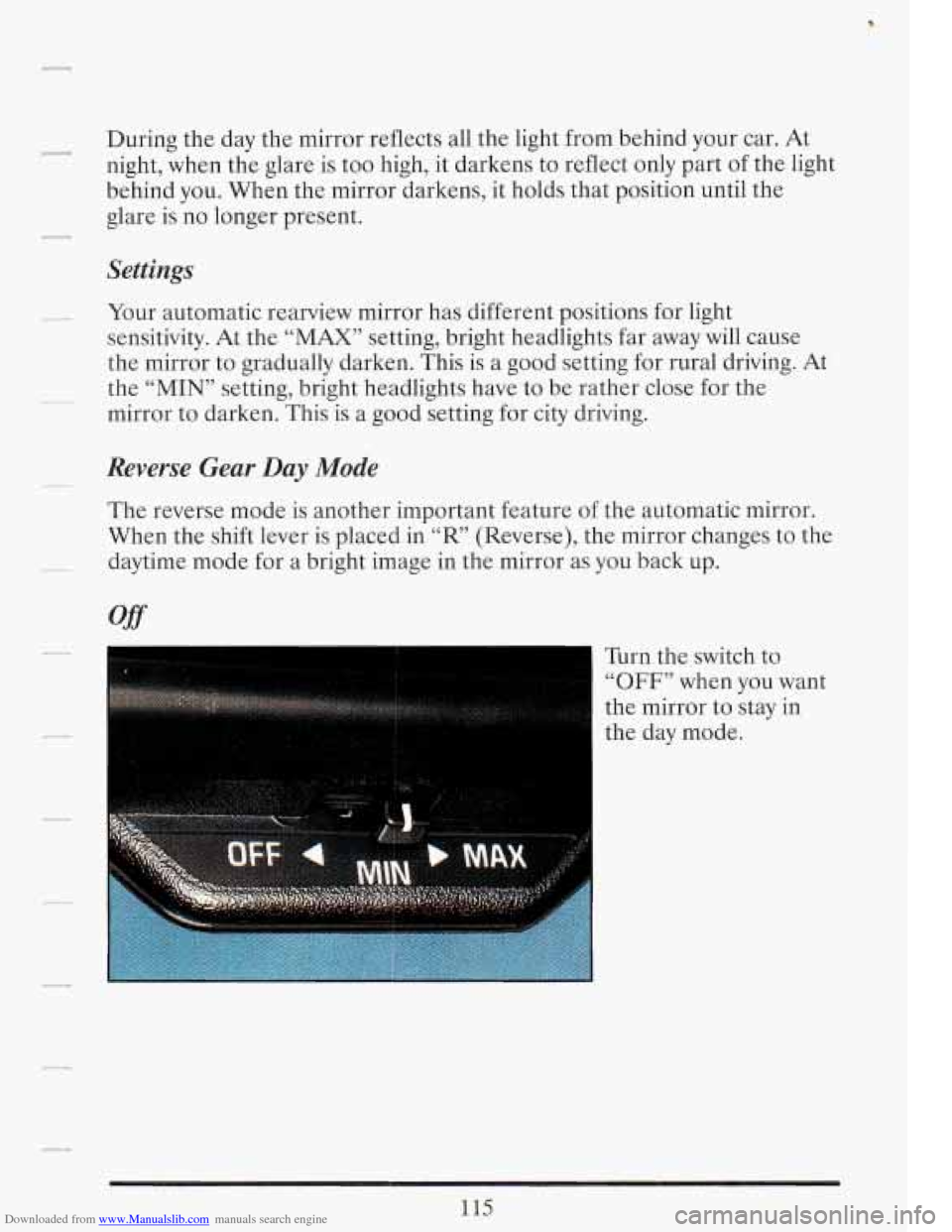
Downloaded from www.Manualslib.com manuals search engine - During the day the mirror reflects all the light from behind your car. At
night, when the glare is too high, it darkens to reflect only part
of the light
behind
you. When the mirror darkens, it holds that position until the
glare is no longer present.
R_
Settings
__ Your automatic rearview mirror has different positions for light
sensitivity. At the
“MAX” setting, bright headlights far away will cause
the mirror to gradually darken. This is a good setting for rural driving. At
mirror to darken. This
is a good setting for city driving.
-- the “MIN” setting, bright headlights have to be rather close for the
Reverse Gear Day Mode
The reverse mode is another important feature of the automatic mirror.
When the shift lever is placed in
“R’ (Reverse), the mirror changes to the
~
__ daytime mode for a bright image in the mirror as you back up.
off
Turn the switch to
“OFF” when you want
the mirror to stay in
the day mode.
115
Page 139 of 386

Downloaded from www.Manualslib.com manuals search engine r WmING AND INDICATOR LIGHTS
This section describes the warning lights that are on your vehicle. The
pictures will help you locate them.
Warning lights can signal that something is wrong before it becomes
serious enough to cause an expensive repair or replacement. Paying
attention to your warning lights could also save you or others from injury.
Warning lights go on when there may be or is a problem with one of your
vehicle’s functions.
As you will see in the details on the next few pages,
some warning lights come on briefly when you turn the ignition key just
to
let you know they’re working. If you are familiar with this section, you
should not
be alarmed when this happens.
When one
of the warning lights comes on and stays on when you are
driving, check the section that tells you what to do about it. Please follow
the manual’s advice. Waiting to do repairs can be costly
-- and even
dangerous.
So please get to know your warning lights. They’re a big help.
Brake System Warning Light
Your Cadillac’s hydraulic brake system is divided into two parts. If one
part isn’t working, the other part can still work and stop you. For good
braking, though, you need both parts working well.
If the warning light
goes on, there could be
a brake problem. Have
your brake system
inspected right away.
125
I_ This light should come on as you start the vehicle. If it doesn’t come on
then, have it fixed
so it will be ready to warn you if there’s a problem.
Page 141 of 386
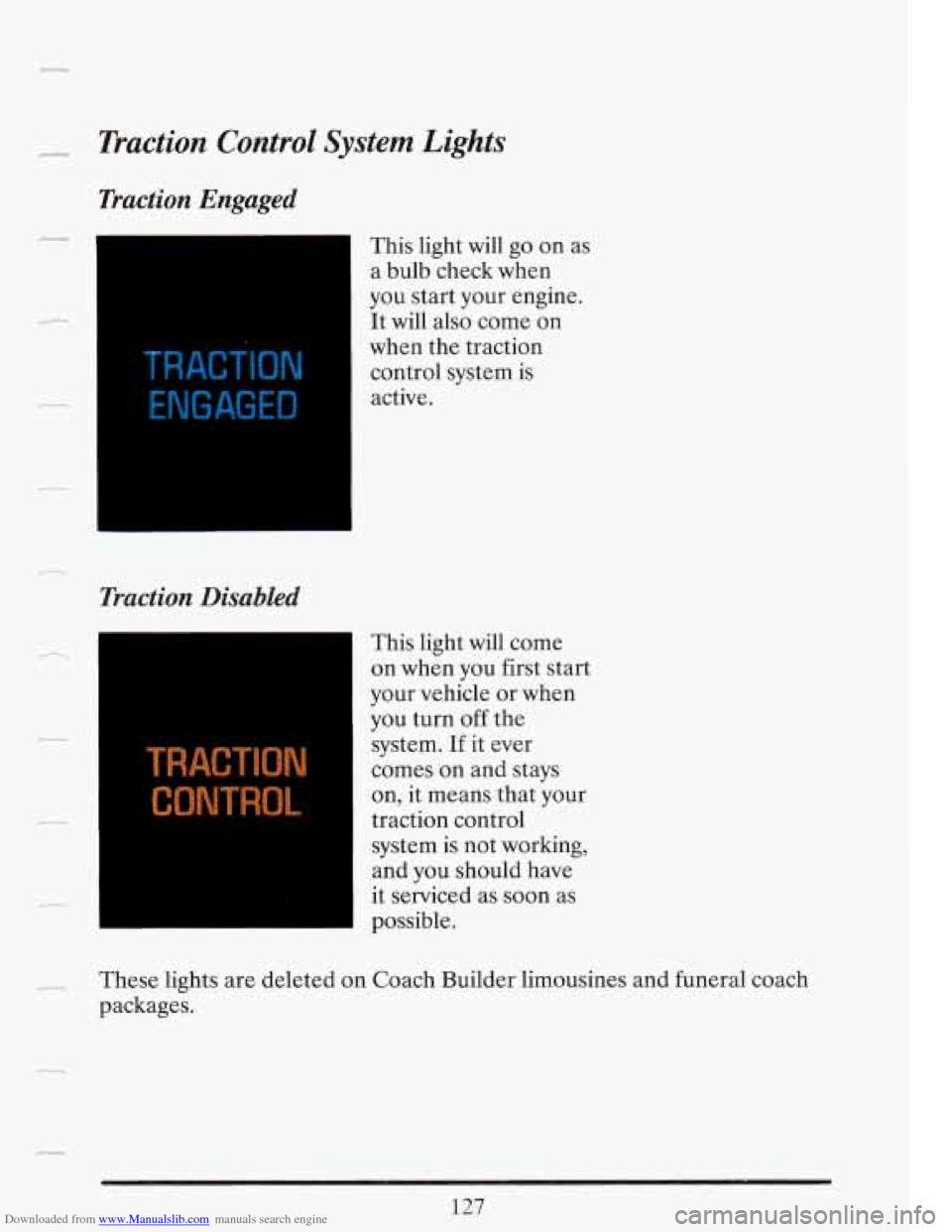
Downloaded from www.Manualslib.com manuals search engine *_* Traction Control System Lights
Traction Engaged
1
TRACTION
ENGAGED
Traction Disabled
This light will go on as
a bulb check when
you start your engine.
It will also come on
when the traction
control system is
active.
This light will come
on when you first start
your vehicle
or when
you turn
off the
system. If it ever
comes on and stays
on, it means that your
traction control
system is not working,
and you should have
it serviced as soon as
possible.
These lights are deleted on Coach Builder limousines and funeral coach
packages.
Page 178 of 386
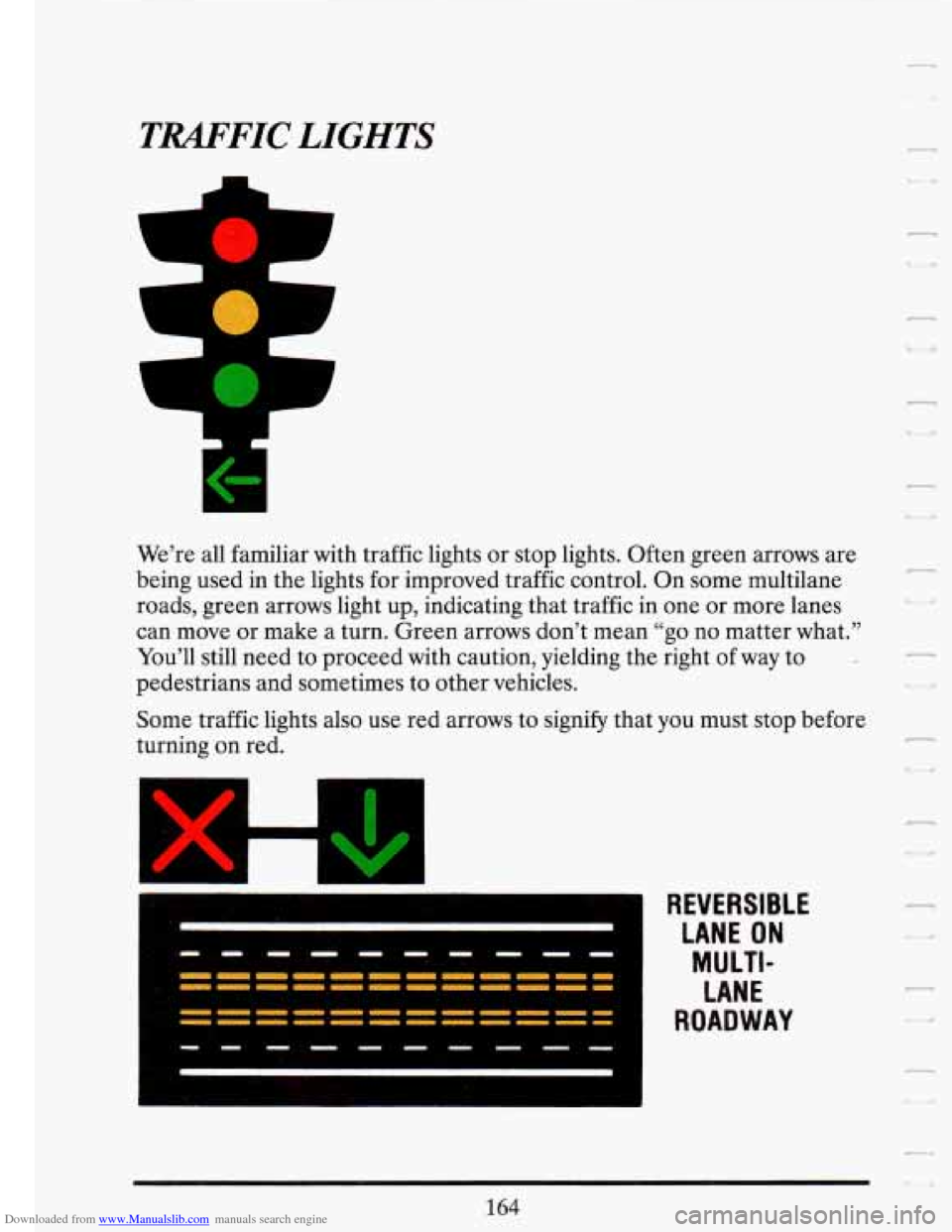
Downloaded from www.Manualslib.com manuals search engine TRAFFIC LIGHTS
r-
L1
We’re all familiar with traffic lights or stop lights. Often green arrows are
being used in the lights for improved traffic control. On some multilane
roads, green arrows light up, indicating that traffic in one or more lanes
can move or make a turn. Green arrows don’t mean “go no matter what.”
You’ll still need to proceed with caution, yielding the right
of way to -
pedestrians and sometimes to other vehicles.
Some traffic lights also use red arrows to signify that
you must stop before
turning on red.
REVERSIBLE LANE ON
M 0 LTl-
LANE
ROADWAY
164
r
U
Page 180 of 386
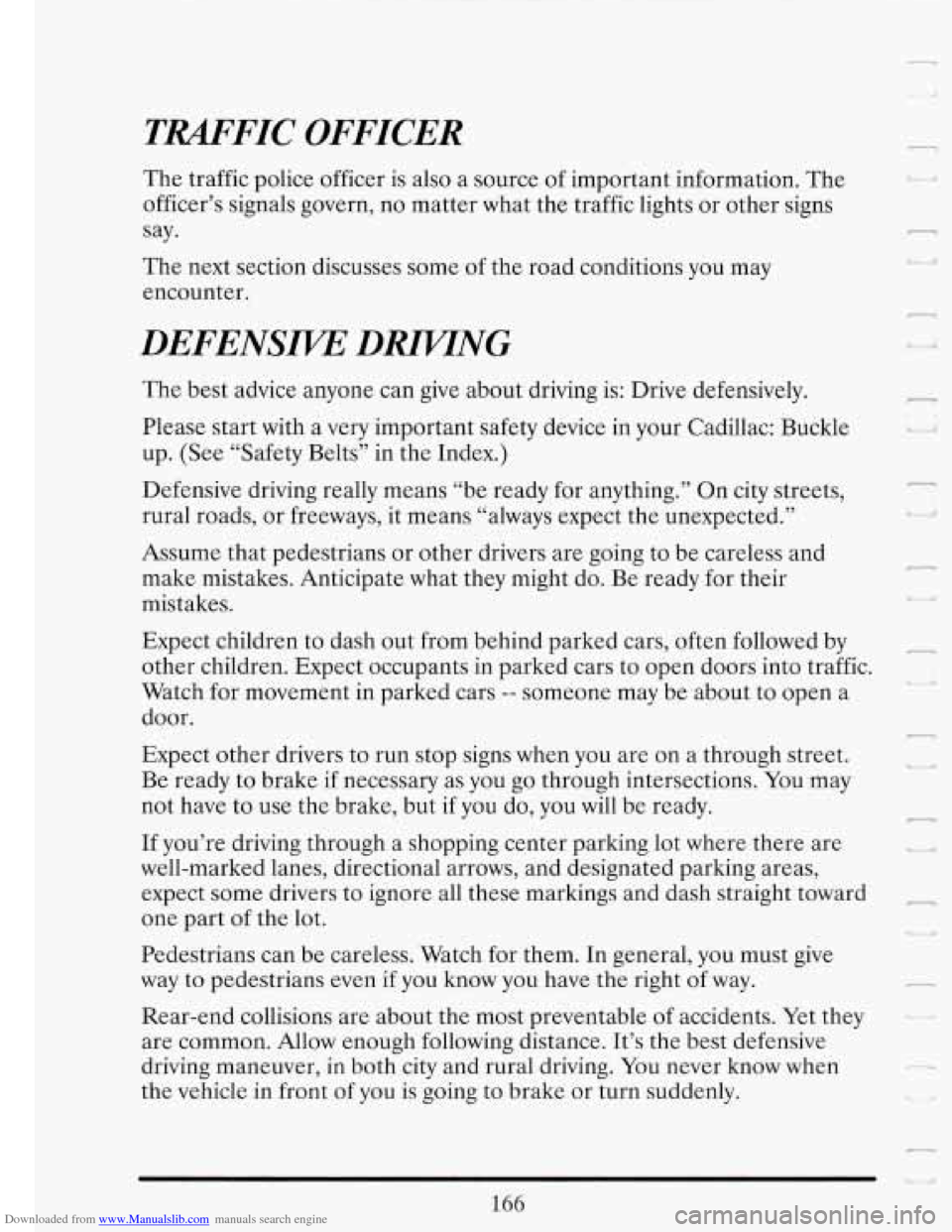
Downloaded from www.Manualslib.com manuals search engine TRAFFIC OFFICER 7 .. I: The traffic police officer is also a source of important information. The
officer’s signals govern, no matter what the traffic lights or other signs
say.
The next section discusses some of the road conditions you may
encounter.
DEFENSIVE DlUVTNG
The best advice anyone can give about driving is: Drive defensively.
Please start with a very important safety device
in your Cadillac: Buckle
up. (See “Safety Belts” in the Index.)
Defensive driving really means “be ready for anything.’’ On city streets,
rural roads, or freeways, it means “always expect the unexpected.”
Assume that pedestrians or other drivers are going to be careless and
make mistakes. Anticipate what they might do. Be ready for their
mistakes.
Expect children to dash out from behind parked cars, often followed by
other children. Expect occupants in parked cars to open doors into traffic.
Watch for movement
in parked cars -- someone may be about to open a
door.
Expect other drivers to run stop signs when you are on a through street.
Be ready to brake if necessary as you
go through intersections. You may
not have to use the brake, but
if you do, you will be ready.
If you’re driving through a shopping center parking lot where there are
well-marked lanes, directional arrows, and designated parking areas,
expect some drivers
to ignore all these markings and dash straight toward
one part of the lot.
Pedestrians can be careless. Watch for them. In general, you must give
way to pedestrians even if you know you have the right of way.
Rear-end collisions are about the most preventable of accidents. Yet they
are common. Allow enough following distance.
It’s the best defensive
driving maneuver,
in both city and rural driving. You never know when
the vehicle in front of you is going to brake or turn suddenly.
166
n
U i I‘
n
u
! I,
r
r
d
-
1
Page 194 of 386
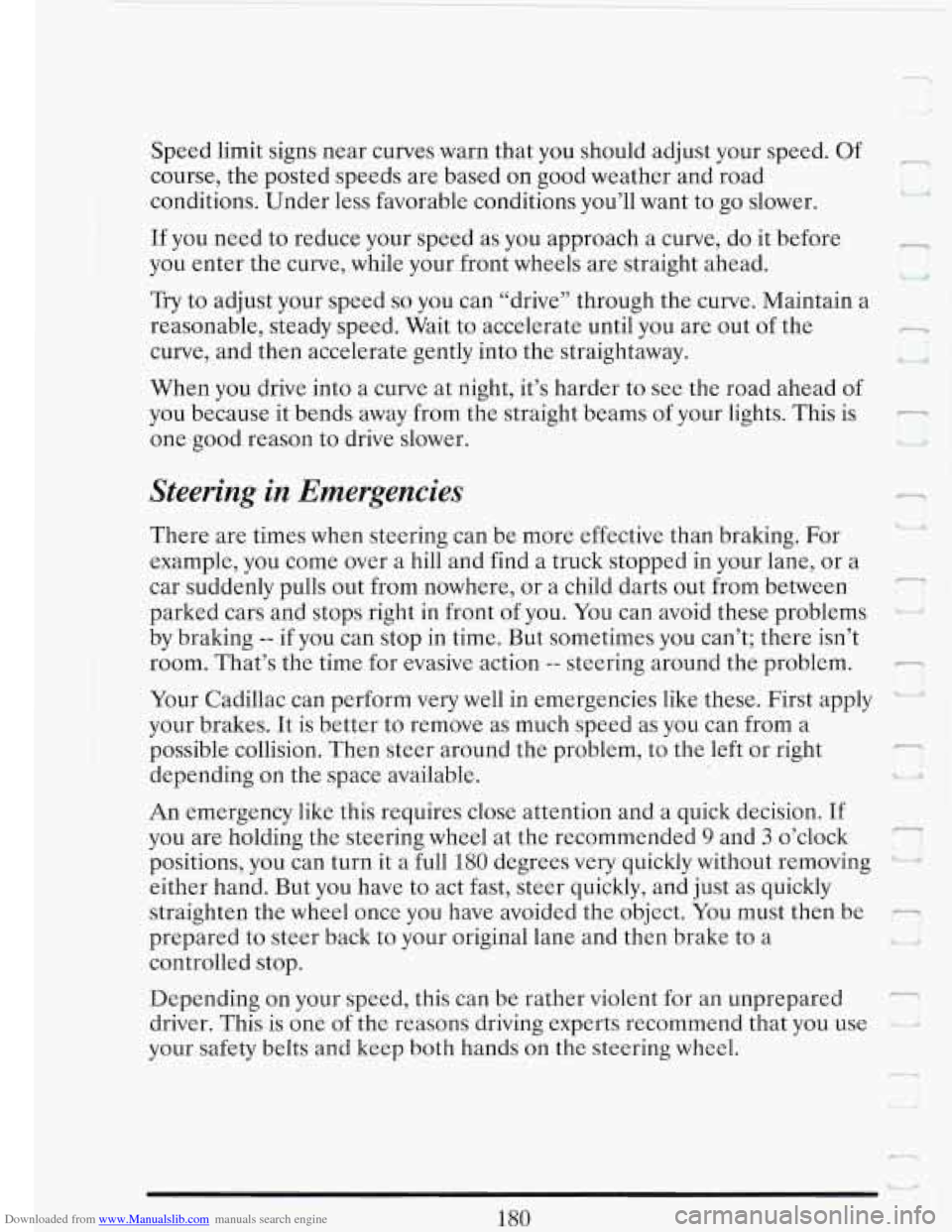
Downloaded from www.Manualslib.com manuals search engine c 1
Speed limit signs near curves warn that you should adjust your speed. Of
course, the posted speeds are based on good weather and road
conditions. Under less favorable conditions you’ll want to go slower.
If you need to reduce your speed as you approach a curve, do it before
you enter the curve, while your front wheels are straight ahead.
Try to adjust your speed so you can “drive” through the curve. Maintain a
reasonable, steady speed. Wait to accelerate until you are out of the
curve, and then accelerate gently into the straightaway.
When you drive into a curve at night, it’s harder to see the road ahead of
you because it bends away from the straight beams of your lights. This is
one good reason to drive slower.
n
cz;
n
Steering in Emergencies
There are times when steering can be more effective than braking. For
example, you come over a hill and find a truck stopped in your lane, or a
car suddenly pulls out from nowhere, or a child darts out from between
parked cars and stops right in front
of you. You can avoid these problems
by braking
-- if you can stop in time. But sometimes you can’t; there isn’t
room. That’s the time for evasive action
-- steering around the problem. -
-
Your Cadillac can perform very well in emergencies like these. First apply
your brakes. It is better to remove as much speed as you can from a
possible collision. Then steer around the problem, to the left or right
depending on the space available. I,
An emergency like this requires close attention and a quick decision. If
you are holding the steering wheel at the recommended
9 and 3 o’clock
positions, you can turn it a full
180 degrees very quickly without removing ‘ i’
either hand. But you have to act fast, steer quickly, and just as quickly
straighten the wheel once you have avoided the object. You must then be
-
7
prepared to steer back to your original lane and then brake to a
controlled stop.
Depending on your speed, this can be rather violent for an unprepared
driver. This is one of the reasons driving experts recommend that you use
your safety belts and keep both hands
on the steering wheel.
-1
r P
180
Page 198 of 386
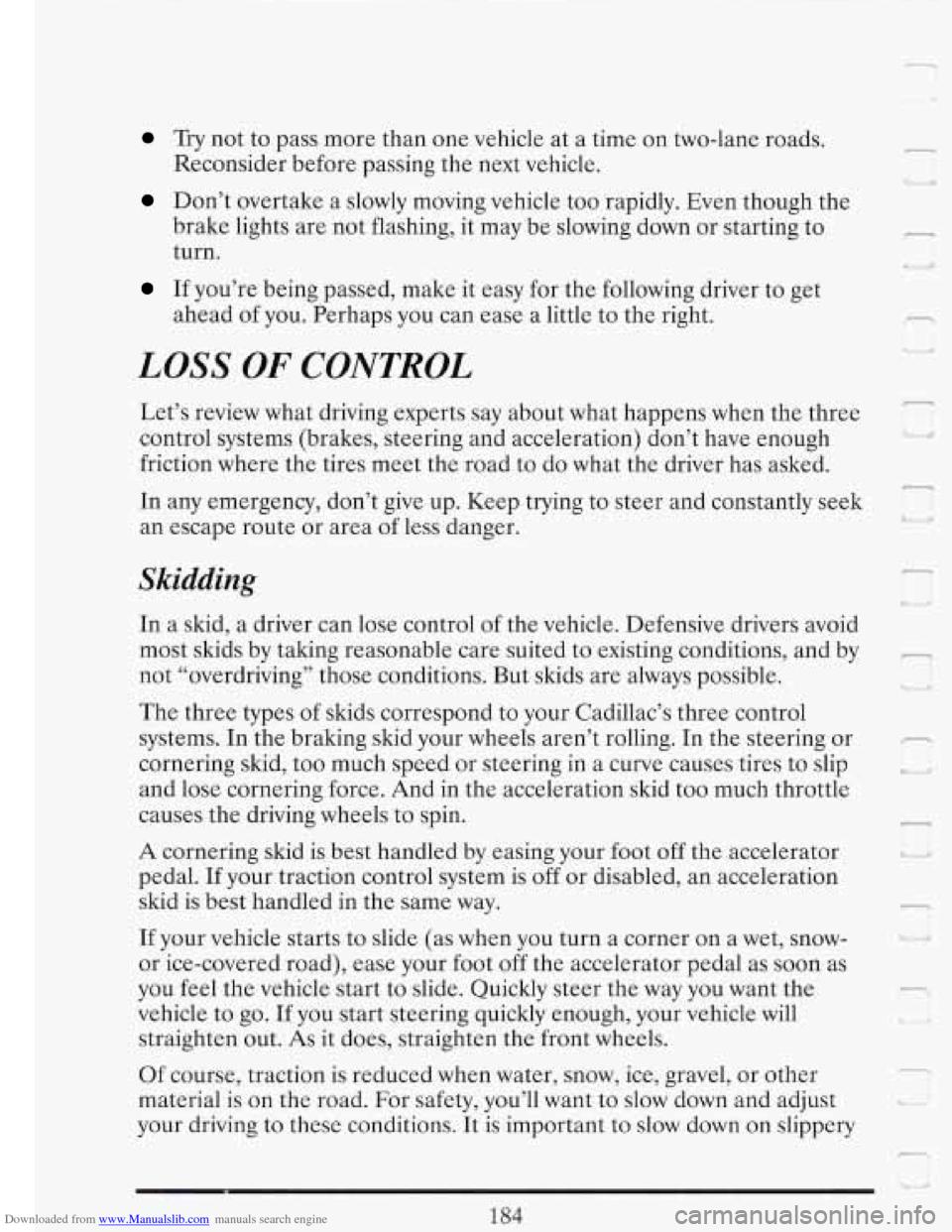
Downloaded from www.Manualslib.com manuals search engine Try not to pass more than one vehicle at a time on two-lane roads.
Reconsider before passing the next vehicle.
Don’t overtake a slowly moving vehicle too rapidly. Even though the
brake lights are
not flashing, it may be slowing down or starting to
turn.
If you’re being passed, make it easy for the following driver to get
ahead
of you. Perhaps you can ease a little to the right.
LOSS OF CONTROL
i
r
I/ U
Let’s review what driving experts say about what happens when the three
control systems (brakes, steering and acceleration) don’t have enough
’; I I
friction where the tires meet the road to do what the driver has asked.
r
In any emergency, don’t give up. Keep trying to steer and constantly seek
an escape route or area
of less danger.
-
le
Skidding
In a skid, a driver can lose control of the vehicle. Defensive drivers avoid
most skids by taking reasonable care suited to existing conditions, and by
._
not “overdriving” those conditions. But skids are always possible. < .,
The three types of skids correspond to your Cadillac’s three control
systems. In the braking skid your wheels aren’t rolling.
In the steering or
cornering skid, too much speed or steering in a curve causes tires to slip
and lose cornering force. And in the acceleration skid too much throttle
causes the driving wheels to spin.
A cornering skid is best handled by easing your foot off the accelerator
pedal.
If your traction control system is off or disabled, an acceleration
skid is best handled in the same way.
If your vehicle starts to slide (as when you turn a corner on a wet, snow-
or ice-covered road), ease your foot off the accelerator pedal as soon as
you feel the vehicle start to slide. Quickly steer the way you want the
vehicle to
go. If you start steering quickly enough, your vehicle will
straighten out.
As it does, straighten the front wheels.
Of course, traction is reduced when water, snow, ice, gravel, or other
material is on the road. For safety, you’ll want to slow down and adjust
your driving to these conditions. It is important to slow down on slippery
Lj
il t
1
-.
184
Page 200 of 386
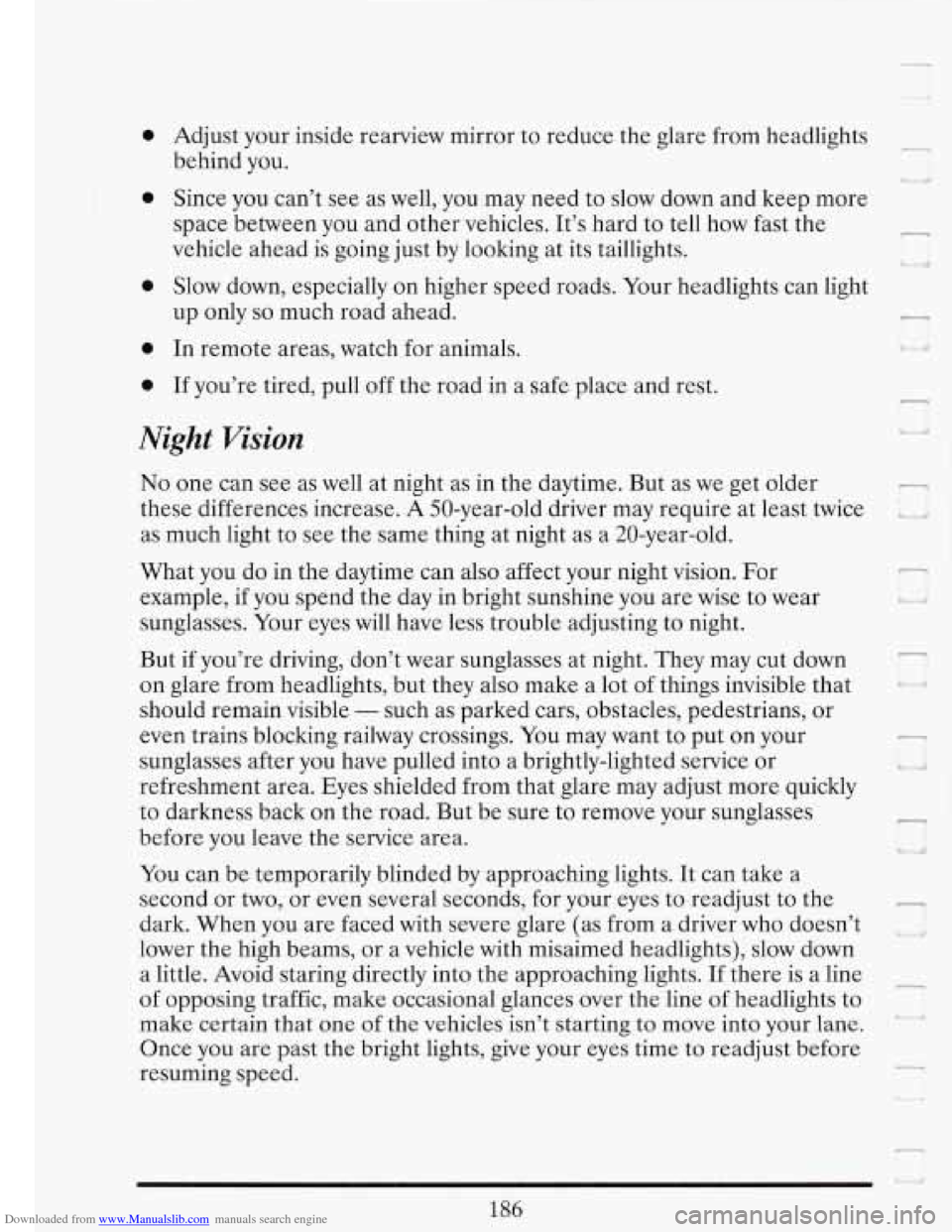
Downloaded from www.Manualslib.com manuals search engine 0
0
0
0
0
Adjust your inside rearview mirror to reduce the glare from headlights
behind you. -
Since you can’t see as well, you may need to slow down and keep more
space between you and other vehicles. It’s hard to tell how fast the
vehicle ahead is going just by looking at its taillights.
Slow down, especially on higher speed roads. Your headlights can light
up only
so much road ahead.
In remote areas, watch for animals.
If you’re tired, pull off the road in a safe place and rest.
Night Vision
f-I
i
No one can see as well at night as in the daytime. But as we get older -
these differences increase. A 50-year-old driver may require at least twice i,
as much light to see the same thing at night as a 20-year-old.
What you do in the daytime can also affect your night vision. For
example, if you spend the day in bright sunshine you are wise to wear
sunglasses. Your eyes will have less trouble adjusting to night.
But if you’re driving, don’t wear sunglasses at night. They may cut down
on glare from headlights, but they also make a lot of things invisible that
should remain visible
- such as parked cars, obstacles, pedestrians, or
even trains blocking railway crossings.
You may want to put on your
sunglasses after you have pulled into a brightly-lighted service or
refreshment area. Eyes shielded from that glare may adjust more quickly
to darkness back on the road. But be sure to remove your sunglasses
before you leave the service area.
I
3:
You can be temporarily blinded by approaching lights. It can take a
second or
two, or even several seconds, for your eyes to readjust to the r
dark. When you are faced with severe glare (as from a driver who doesn’t
lower the high beams, or a vehicle with misaimed headlights), slow down
a little. Avoid staring directly into the approaching lights.
If there is a line
of opposing traffic, make occasional glances over the line of headlights to
make certain that one of the vehicles isn’t starting to move into your lane.
Once you are past the bright lights, give your eyes time to readjust before
resuming speed.
I.-
-
i*
It 81
186